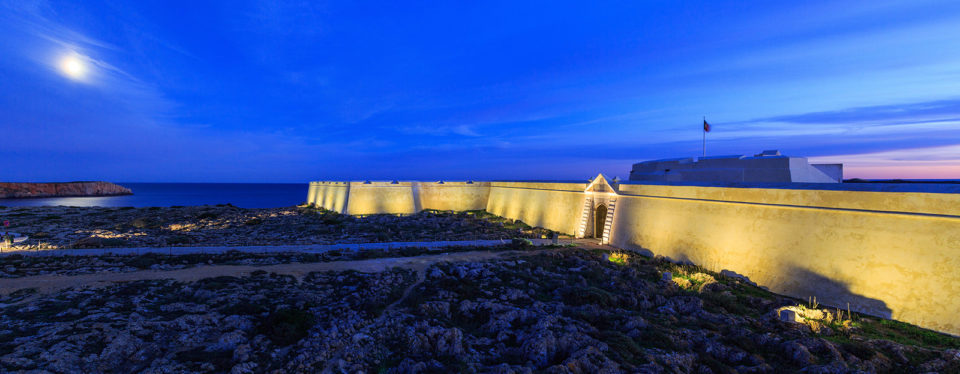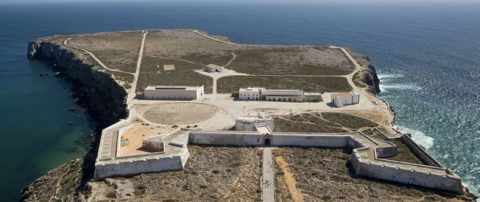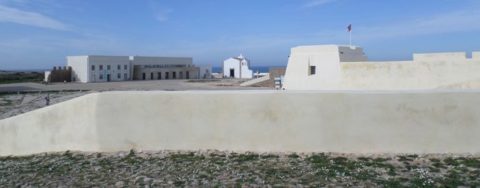
The story of Sagres is also that of the Costa Vincentina, a large area of the Southwest coast of the Algarve, moulded into shape by the sea and called by the Ancients the Promontorium Sacrum. The furthest point of the then-known world, its coastal escarpment covered with coarse vegetation and constantly swept by the wind, is broken by capes and rocks into a natural scenario of rare beauty and quality.
This region contains a surprising number of Neolithic menhirs, isolated or in small alignments or groups. Sagres entered definitively into the history and legends of the ancient world as from the 8th century B.C., when the products of what was then the Far West attracted Mediterranean mariners. This was the last sheltered port where shipping from the Levant could put in before setting out into the open Atlantic. The crews climbed the promontory, consulted the gods and made vows, gestures that transformed the Promontorium Sacrum into a basic point of reference for seagoing men.
In 7th century documents it is referred to as a Statio Sacra and in 779, according to local religious tradition, the mortal remains of St. Vincent, the 4th century martyr of Zaragoza cast adrift in Valencia arrived at the Promontorium Sacrum, ending their voyage from east to west. They were laid to rest in the church of Corvo (Raven), in a monasterium that authors tend to place on the inhospitable cliffs of Cape St. Vincent, but was most likely to have been further inland, perhaps in the Raposeira area where there was a Late Antiquity settlement and where horticulture was sufficient to sustain a small monastery. Under Muslim rule the Vincentine cult attracted numerous pilgrims – Christians from the North, Muslims and Mozarabs. It retained its vitality until the mid-12th century, when Almoravid fanaticism led to the destruction of the sanctuary. The relics of St. Vincent were retrieved by sea and laid to rest in Lisbon, which had just been conquered from the Moors.

Three centuries later, recognizing the enormous importance of the sea as a source of revenue, the Infante D. Henrique, Prince Henry, already the owner of property in Lagos and Raposeira, obtained a grant from the Regent, Infante D. Pedro, his brother, to create the Vila do Infante on the promontory. Documents refer to the construction of the town at a place “called Terçanabal”, indicating that the new settlement was founded on the ruins of an old one.
The Infante D. Henrique was to spend his declining days there. Various letters and his last will and testament were written and dated from his house, where he died on November 13th, 1460. However, considerable erosion and the course of history have left few remains of the settlement: only traces of a saw-tooth wall (that which Francis Drake, the famous British navigator and privateer attacked and occupied in 1587, one of his companions on the expedition having made a detailed map that included drawings of all the fortresses situated between Cape St. Vincent and Baleeira), a cistern tower, the foundations of a windbreak wall (now heavily restored and crowned by false battlements). Then there is the so-called windrose or mariner’s compass, a curious paving discovered, by chance, in 1921. Worthy of notice are also the supposedly authentic assemblage of the Correnteza, formerly a row of buildings integrated into the present day exhibition module.
 Little dates from beyond the 16th century: the church of Nossa Senhora da Graça (Our Lady of Grace), the reconstruction of which included the doorway, applied later: the bastioned wall, remodelled at the end of the 18th century; the former house of the governor of the fort, and a curious reconstructed building on a site that some suggest, with no grounding whatsoever, might have been the residence of the Infante D. Henrique.
Little dates from beyond the 16th century: the church of Nossa Senhora da Graça (Our Lady of Grace), the reconstruction of which included the doorway, applied later: the bastioned wall, remodelled at the end of the 18th century; the former house of the governor of the fort, and a curious reconstructed building on a site that some suggest, with no grounding whatsoever, might have been the residence of the Infante D. Henrique.
It is the mythical atmosphere of the place that, still and always, will appeal to the more obscure and irrational side of our collective memory.
Controversial questions have been raised about the architectural intervention of the 90’s, which sought to transform the built-up part in the space available in the great monument that is actually the entire promontory, with respect for the place but without being influenced by historic style. The Correnteza, partially demolished in the 1950’, but maintaining the idea of a square between the buildings and wall, houses an exhibition centre and services for visitors to make full use of this historical memorial.


